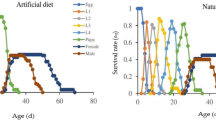Abstract
Diet change in the cotton stainers, Dysdercus cardinalis and D. fasciatus, occasioned by their migration from Gossypium hirsutum (cotton) to alternate hosts Sterculia rhynchocarpa and Adansonia digitata, was overall beneficial to their bionomics. Only the host Abutilon mauritianum appeared to possess antibiotic effects against the fecundity, fertility and longevity of the stainers. The occurrence in tropical natural ecosystems of both suitable and unsuitable hosts appears to constitute a vital and a viable stainer population-regulatory mechanism. Overall, D. cardinalis exhibited superior reproductive parameters on a variety of diets than did D. fasciatus. The latter apparently suffered profound negative effects on its bionomics when feeding on certain hosts.
Résumé
Le changement d’alimentation chez les punaises du coton, Dysdercus cardinalis et D. fasciatus, résultant de leur migration du coton, (Gossypium hirsutum), vers d’autres plantes-hôtes comme Sterculia rynchocarpa et Adansonia digitata était globalement bénéfique pour leurs bionomies. Seul Abutilon mauritianum qui est aussi une plante-hôte, a révélé des effets antibiotiques sur la fécondité, la fertilité et la longévité de ces punaises. La présence des plantes nourricières propres et celles qui ne sont pas propices semble constituer un noeud vital de régulation des populations de ces punaises. De surcroît, D. cardinalis a fait montre des paramètres supérieurs de reproduction sur une large gamme de diètes plus que D. fasciatus. Cette dernière punaise était apparemment affectée par des effets négatifs très prononcés dans ses bionomies, une fois qu’elle était élevée sur certaines plantes-hôtes.
Similar content being viewed by others
References
Ahmad I. (1979) Effects of different plant food on fecundity, fertility and development of Dysdercus cingulatus (Fahr.). Indian J. Zool. 7, 13–15.
Ballard E. and Evans M. G. (1928) Dysdercus sidaeMontr. in Queensland. Bull. Ent. Res. 18, 405–435.
Bebbington A. G. and Allan W. (1936) The food cycle of Dysdercus fasciatus in Acacia savannah in Northern Rhodesia. Bull. Ent. Res. 27, 237–249.
Bohlen E. (1973) Crop Pests in Tanzania and Their Control. Federal Agency for Economic Co-operation, Berlin, Hamburg.
Cowland J. W. and Ruttledge W. (1927) Notes on cotton Stainers (Dysdercus) in Sudan. Bull. Ent. Res. 18, 159–163.
De Pury J. M. S. (1974) Crop Pests in Tanzania and Their Control. Oxford University Press, Nairobi. 227 pp.
Derr J. A. (1980) Coevolution of the life history of a tropical seed-feeding insect and its food plants. Ecology 64, 881–892.
El-Heneidy A. H. and Sekematte M. B. (1996) Contribution of trap crops in the integrated control of insect pests of cotton in Uganda. Ann. Agrie. Sci. Mohtohor 34, 1229–1246.
Geering O. A. and Coaker T. H. (1960) The effects of different plant foods on fecundity, fertility and development of cotton stainer Dysdercus superstitious (F.). Bull. Ent. Res. 51, 61–76.
Harry F. and Althoen S. C. (1995) Statistics Concepts and Application, pp. 402–408; 482–569. Cambridge University Press, London.
Hill D. S. (1975) Agricultural Insects of the Tropics and Their Confrol. CambridgeUniversity Press, London. 659 pp.
Janzen D. H. (1971) Seed predation by animals. Annu. Rev. Ecol. Syst. 2, 265–492.
Kasule F. K. (1985) A comparison of the reproductive strategies of three species of Dysdercus from Africa (Hemiptera: Pyrrhocoridae). Oecologia 65, 260–265. Univ. of Dar-es-Salaam.
Kasule F. K. (1991a) Quantitative variation in adult size and fecundity of the cotton stainer bug Dysdercus fasciatus. Heredity 66, 273–279.
Kasule F. K. (1991b) Associations of fecundity with adult size in the cotton stainer bug Dysdercus fasciatus. Heredity 66, 281–286.
La Croix E. A. S. (1966) Stainer bugs (Dysdercus spp.) in Coast Province of Kenya. Emp. Cott. Grow. Rev. 43, 41–55.
Leather S. R. (1984) The effect of adult feeding on fecundity, weight loss and survival of the pine beauty moth, Panolis flammea (D&S). Oecologia 65, 70.
Le Pelley R. H. (1959) Agricultural Insects of East Africa. East Africa High Commission, Nairobi, Kenya. 307 pp.
Mambiri A. M. and Khaemba B. M. (1988) Susceptibility of Dysdercus species Biosduval (Hemiptera: Pyrrhocoridae) to selected synthetic pyrethroids. Insect Sci. Applic. 9, 309–312.
Matthews G. A. (1989) Cotton Insect Pests and Their Management. Univ. of London. CAB International. 599 pp.
Matthews G. A. and Broodryk H. B. In Matthews G. A. and Tunstall J. P. (1994) Insect Pests of Cotton. 593 pp. CAB International.
Pearson E. D. (1958) The Insect Pests of Cotton in Tropical Africa. Commonwealth Institute of Entomology, London. 353 pp.
Prentice A. N. (1972) Cotton With Special Reference to Africa. Longmans, London. 206 pp.
Rainey R. C. (1948) Observations on the development of cotton boll, with particular reference to changes in susceptibility to pests and diseases. Ann. Appl. Biol. 35, 64–83.
Schmutterer H. (1969) Pests of Crops in Northeast and Central Africa. Fischer-Verlag, Stuttgart, Germany. 296 pp.
Sokal R. R. and Rohlf F. J. (1981) Biometry. The Principles and Practices of Statistics in Biological Research. Freeman and Company, New York. 859 pp.
Tengecho B. (1994) Distribution and occurrence of some cotton Stainers (Heteroptera: Insecta) on different host plants at Masongaleni Machakos district, Kenya. Insect Sci. Applic. 15, 49–54.
Von Herzog A. (1967) Ernahrungs-und stoffwechselunter suchungen on imagines der afrikanischen Baumwollwanze Dysdercus fasciatus Sign. (Hemiptera: Pyrrhocoridae). Z. Angew. Entomol. 60, 351–386. Univ. Basel.
Author information
Authors and Affiliations
Rights and permissions
About this article
Cite this article
Tengecho, B., Khaemba, B.M. Effects of Diet Change on the Reproductive Parameters of the Cotton Stainers Dysdercus cardinalis and D. fasciatus (Hemiptera: Pyrrhocoridae). Int J Trop Insect Sci 18, 211–215 (1998). https://doi.org/10.1017/S1742758400023420
Accepted:
Published:
Issue Date:
DOI: https://doi.org/10.1017/S1742758400023420
Key Words
- cotton stainers
- Dysdercus cardinalis
- D. fasciatus
- diet change
- alternate hosts
- fecundity
- fertility
- longevity




